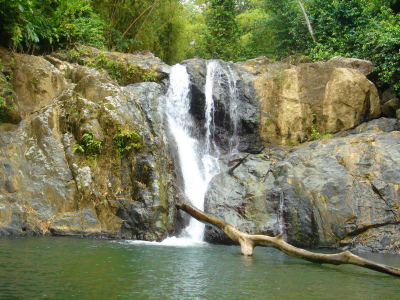
|
|
 |
||||||||||||||||||||
|
|
|||||||||||||||||||||
|
TOBAGO'S RICHES Stepping Back in Time on a Caribbean Island Paradise By Skip Kaltenheuser If you ask a cab driver in Tobago his family's ancestry, be prepared to hear a long story about a well-branched family tree likely to include Europeans, Amerindians, Africans, Indians, Chinese, Portuguese, and Arabs. They all bring something to the cultural mix of the island’s residents, and as a result there’s a rich human component. But Tobago’s riches also extend to its unspoiled natural environment.  Among the island’s offerings is the Main Ridge Reserve, created to ensure that sugar planters wouldn't fell all the trees for timber. There was a remarkable realization by a mid-18th century scientist named Stephen Hales that taking down the trees would eventually end the moisture cycles that brought rain, turning islands like Tobago into a desert and ending all agriculture there. It was a tough sell in the British Parliament (where many members also owned plantations in Tobago), but after eleven years of effort, one member, Soame Jenyns, convinced his colleagues that Hales was correct. Protected by law in 1776 (not to preserve royal hunting and pleasures, but to protect the watershed), this is the world's oldest legally-protected forest reserve of its kind. The act that created the reserve is a marvel of environmental foresight that much of the world could still greatly benefit from emulating: "In pursuance of your said Instructions, (we) remove to Your Majesty a tract of Wood Land lying in the interior and most hilly parts of this island for the purpose of attracting frequent Showers of Rain upon which the Fertility of Lands in these Climates doth entirely depend.” Most of the forest, which now covers over two-thirds of the island, is very similar to the type that dominates in the Amazon.  However, unlike Trinidad, there are no poisonous snakes in the forests of Tobago, making them a worry-free pleasure to hike. Waterfalls abound, including Argyle Waterfall, which has 175-feet of stepped cascades and cold, deep pools to swim in. Along the walk to the falls from a visitor’s center, caymans laze in the river, and 469 species of birds flock, nest and perch - including many hummingbirds. However, unlike Trinidad, there are no poisonous snakes in the forests of Tobago, making them a worry-free pleasure to hike. Waterfalls abound, including Argyle Waterfall, which has 175-feet of stepped cascades and cold, deep pools to swim in. Along the walk to the falls from a visitor’s center, caymans laze in the river, and 469 species of birds flock, nest and perch - including many hummingbirds.Beyond the local birds, from August to October the islands are visited by migratory species from North America. But there are also interlopers from South America, such as the nation's national bird: the scarlet ibis. It breeds in Venezuela (which is so close it can be seen from Trinidad), but spends  most of its time feeding in mangrove swamps on the island. most of its time feeding in mangrove swamps on the island.The north end of Tobago is the island's most mountainous, and the beautiful bays on the Caribbean side are great for swimming, with extensive protective reefs for snorkeling. Visitors might recognize locations like Pirates Bay that was used in the 1952 film Swiss Family Robinson, and although you might have to hike aways from small villages on the Caribbean side, it's not unusual to find coves and beaches you can have entirely to yourself. Just off the southeast side of the far end of Tobago is a small island, Little Tobago, across from Starwood Bay and the Blue Water Inn resort. There’s good snorkeling and diving, with the world's largest-known brain coral, and many leatherback turtles; but be warned: the Atlantic currents are powerful, and a good guide and experienced boatman are necessary to keep you from harm's way. Little Tobago is also a bird sanctuary with boobies, terns and the red-billed tropic bird, and offers some challenging hiking up steep slopes covered in parts by cactus and dry forest, but with much denser forest toward the top, and huge ferns. Whether you make it out to Little Tobago, or you only have time for the main island itself, you’ll not be wanting for a wealth of experiences that will truly allow you to “get away from it all.” Thanks to the foresight of some robed, white-wigged parliamentarians 200-plus years ago, we can still experience a wilderness not easily found in the hustle-and-bustle of today’s cruise ship-laden Caribbean. FAST FACTS Tobago Division of Tourism www.visittobago.gov.tt Skip Kaltenheuser ("Have Pen Will Travel") is a writer/photographer based in Washington, D.C. He can be reached at: skip.kaltenheuser@verizon.net Photo credits: iStockphoto.com Posted April 2010 *Portions of this article appeared previously in Natural Traveler magazine (www.naturaltraveler.com) |
|
|
|
|
| Site Map |